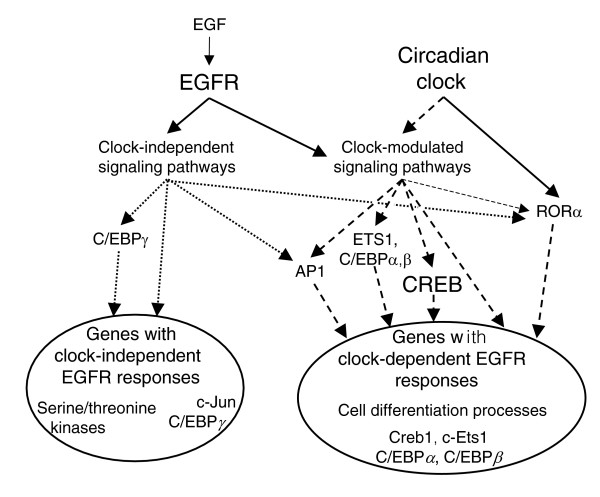Figure 3.

Hypothesized regulatory interactions that partially account for circadian time dependent EGFR transcriptional responses in the SCN. Modulation of the SCN gene expression response to EGFR activation (via EGF) by the circadian clock was investigated in the present study. We identified groups of genes with both CT-dependent and CT-independent expression responses, and these groups were enriched for specific cellular functions and the presence of specific TF binding sites in their promoters. Genes with CT-independent EGF responses were enriched for serine/threonine kinase activity and for C/EBPγ binding sites in their promoters. Given their CT-independent responses, and given that we observed weak CT-independent C/EBPγ expression responses to EGF, it is plausible that the EGFR-regulated signaling pathways responsible for their induction through C/EBPγ-dependent and -independent mechanisms function independently of the circadian clock. Genes with CT-dependent responses were enriched for involvement in cellular differentiation processes and the presence of c-Ets1, AP1, C/EBP, RORα, and CREB binding sites. Although RORα is a direct regulatory target of the circadian clock, we did not observe CT or EGFR expression responses for this gene and, thus, it may cause EGF induced CT-dependent gene regulation through post-transcriptional mechanisms. On the other hand, we did observe CT-dependent EGFR expression responses of c-Ets1, Creb1, C/EBPα, and C/EBPβ, constituting a mechanism by which these genes may cause CT-dependent expression responses of their target genes, and indicating that these TFs must be regulated by CT-dependent pathways. Interestingly, c-Jun EGFR expression responses were CT-independent, indicating that it must regulate CT-dependent expression responses through CT-dependent post-transcriptional mechanisms. Solid lines indicate direct interactions, dotted lines represent indirect CT-independent interactions, and dashed lines represent indirect CT-dependent interactions. CREB is emphasized given the strong support provided by multiple independent analyses for its involvement in the EGFR response.
